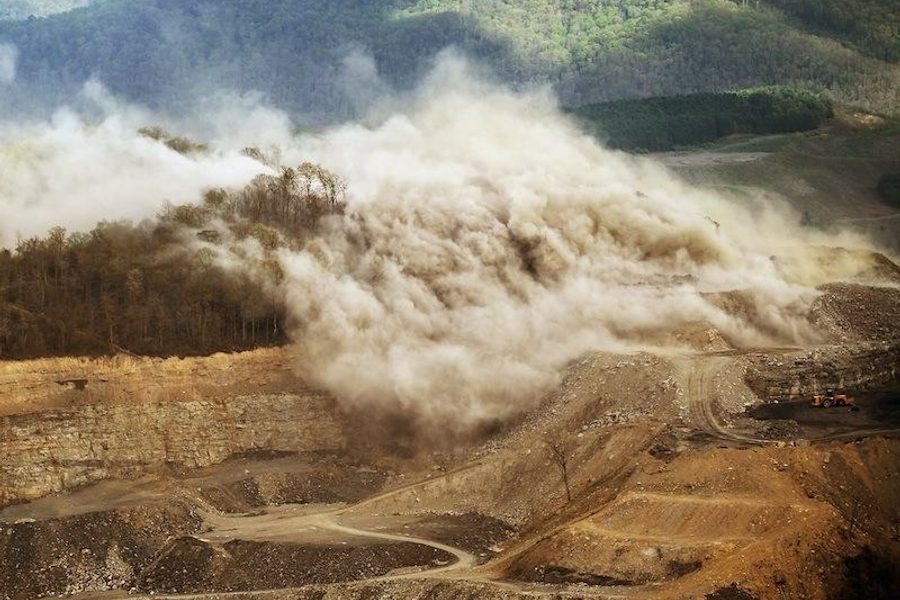Coal-ateral Damage
Appalachian environmentalists call a proposed 110-mile expressway ‘mountaintop removal disguised as a highway.’
Cole Stangler

The isolated, mountainous border counties of southwest Virginia are among the poorest in the nation, still reeling from the roughly three-decade decline of Appalachia’s coal industry. In Buchanan, Dickenson and Wise counties, household median incomes range from the low $20,000s to the $30,000s — less than half the state average — and the poverty rate hovers around 20 percent, nearly double the state average.
Given the region’s economic troubles, it’s perhaps unsurprising that many top local officials support the construction of the 110-mile, four-lane Coalfields Expressway from Pound, Va. to Beckley, W. Va., which is projected to bring in thousands of new jobs, mostly in construction.
But others see the proposed highway as a potential cover for something far more sinister — an opportunity for coal companies to gobble up land for environmentally devastating strip mining like mountaintop removal, with little to no regulation.
“The project that’s being proposed is just mountaintop removal being disguised as a highway,” says Kate Rooth, a Charlottesville, Va.-based campaign director for the environmental group Appalachian Voices, which has organized opposition to the project.
Not just any highway
Since 1995, when Congress first designated the route as a “High Priority Corridor,” federal and state legislators have supported the construction of a highway as a potential catalyst for much-needed economic development. And a little more than a decade ago, large-scale construction seemed imminent. In 2000, the West Virginia portion of the route cleared the federal and state approval hurdles. And in 2001, the Federal Highway Administration (FHWA) issued an environmental impact statement on the Virginia portion of the route, essentially giving the project a green light pending state funding.
West Virginia has since completed and opened about seven miles of the highway to traffic, but a lack of funding has delayed most of the route’s construction in the state. Meanwhile, the original plan in Virginia came with a hefty price tag of $5 billion — apparently too much, the state decided, for it to shoulder alone. So a few years later, the Virginia Department of Transportation (VDOT) entered into a public-private partnership with coal companies Pioneer Energy and Alpha Natural Resources, one of the nation’s largest mining companies, to undertake the project at an estimated $2.8 billion cost to the state. Under what the partnership calls “coal synergy,” the mining companies are planning on clearing the way for the road — but with a catch. They want it rerouted so that it can access untapped coal reserves along the way. Alpha maintains that any coal mined is incidental to the project and not the primary reason for the rerouting.
Now VDOT is finalizing an environmental assessment of the most mining-intensive section of the new coal-friendly route — and is soon expected to forward that assessment to the FHWA. Approval by the highway administration could trigger construction as early as next month.
Critics of the project claim, however, that the VDOT’s environmental “assessment” isn’t enough to guarantee ecological safety in the region.
“An environmental assessment isn’t thorough,” says Rooth. “It doesn’t consider to the level that’s necessary and the level that’s required by law the impacts of the project. It’s a very cursory type of assessment.”
The assessment did not include any mention of the potential impact of mountaintop removal, a type of strip mining in which operators blast apart mountaintops to expose coal seams and often dump the waste into adjacent valleys. Studies have shown that people living near such mines suffer from elevated cancer rates and birth defects. The practice is also commonly associated with air pollution and water pollution — most notably, as the Environmental Protection Agency (EPA) has documented, as a result of mining debris burying streams.
“The environmental impact is most noticeable through stream health and the rapid poisoning of streams,” says Marley Green, a Sierra Club organizer who lives in the town of Appalachia in Wise County. “These are headwater streams that go into rivers that serve as drinking water for people downstream.”
Instead, opponents say, the FHWA needs to ask for an environmental impact statement covering the entirety of the Coalfields Expressway route in Virginia — something that still hasn’t been done since 2001. They say it’s the logical thing to do, not to mention a requirement of the National Environmental Policy Act. Last month, Appalachian Voices, the Sierra Club, Southern Appalachian Mountain Stewards and their allies rallied outside the FHWA headquarters in Washington, D.C. with that demand.
The environmental footprint of the “coal synergy” route is much more significant than the original route: Construction would impact twice as many acres of land, mostly forest, three times as many miles of streams and 34 acres of wetlands.
Most of the proposed route in Dickenson County would impact streams that eventually drain into the John W. Flannagan Reservoir — a source of drinking water for a number of towns in the immediate vicinity. “It doesn’t necessarily mean that people are going to be drinking polluted water from that reservoir, but we’re having to pay to clean it up to drink that water,” Green says.
It’s not just the coalition of green groups that’s concerned about the lack of oversight. The U.S. Army Corps of Engineers, the U.S. Fish and Wildlife Service and the Environmental Protection Agency have all called for a supplemental environmental impact statement covering the full route.
And frustrations over the review process aside, critics are upset about the prospect of additional mountaintop removal in a region that’s already seen more than its fair share.
“This kind of mining hurts people and communities,” says Green. “And sure, it hurts the environment, but people feel it right away. It’s blasting, it’s dust from the blast, from the mine, and it’s increased flooding like we’ve seen with the King Coal Highway in West Virginia.”
Construction of that highway — which also relied on “coal synergy” in conjunction with Alpha Natural Resources—was found to be responsible for flooding in southern West Virginia in May 2009.
What’s more, the nature of the public-private partnership could allow Alpha Coal, which would operate the bulk of the mining projects alongside the route, to avoid the standard mining regulations that private companies are normally subject to. Since it’s financed with public money, the construction of the Coalfields Expressway can qualify for a “government-financed exemption” — in other words, effective immunity from Virginia’s basic surface mining regulations, and in turn, the equivalent federal law. The exemption applies to publicly funded construction projects that include the “extraction of coal” as an “incidental part” of operations.
“If they were applying for these permits as coal mining permits to the Army Corps of Engineers, I believe strongly that the scale of these mountaintop removal sites would require an environmental impact statement in their own right, and the Army Corps would require that they do that,” says Rooth. “They’re getting around that process in this case by using this public-private partnership.”
Though a spokesperson for the Virginia Department of Mines, Minerals and Energy (DMME) says that VDOT and its private partners have yet to apply for the exemption, VDOT spokesperson Michelle Earl confirms her agency seeks to do just that. “VDOT’s public-private transportation partners must secure a Government Financed Exemption for all incidental coal recovered,” she says.
If the Virginia DMME grants the exemption, state officials will still have to perform monthly check-ups to make sure that the highway is meeting a basic level of requirements — primarily, that all the coal recovered is not beyond what’s required as an “engineering necessity,” according to DMME spokesperson Mike Abbott. It’s hard to imagine that being much of a barrier, considering the proposed route has already been specifically redirected to access coal reserves (VDOT also gets to define what qualifies as an “engineering necessity”). But those monthly check-ups are the extent of the government’s oversight.
Meanwhile, all the core provisions of the federal Surface Mining Control and Reclamation Act — requirements that mine operators use the appropriate explosives, notify nearby residents of the blasting schedules, not degrade water quality, properly dispose of waste and restore mined land to its previous condition — would not apply.
Essentially, it’s up to VDOT and its partners in the coal industry to do as much of that as they see fit.
“Those kinds of activities would be basically under the purview of the agency who is contracted for the work. In this case, you’re talking about VDOT,” says Abbott.
An uphill battle?
In spite of all this, the Coalfields Expressway seems to benefit from at least mild community support.
“We’ve had public hearings on the project over the years and response has always been very favorable toward the project and the possibility of having new roads in that region,” says Michelle Earl, a spokesperson for VDOT.
Green doesn’t dispute that. “It’s been difficult to get people to speak out,” he says.
After all, the project carries with it promising job figures — despite the fact that unlike traditional underground coal mining, surface mining is largely mechanized. The state estimates the Coalfields Expressway will create about 30,000 jobs, mostly in construction, in the Buchanan, Dickenson and Wise counties over 17 years.
But that figure may be overly optimistic.
The Richmond-based firm that performed the estimate, Chmura Economics & Analytics, has previously come under fire for its cozy relations with Governor McDonnell’s administration, for whom it’s produced an array of glowing economic forecasts. They include projections that a nine-day long cycling event in the state capital would reel in almost half a million biking enthusiasts and $158 million, and that a new NFL summer practice facility would attract 100,000 spectators in addition to $8.5 million each year. Last May, Chmura projected the Governor’s transportation plan would create more than 13,000 jobs and bring in $9.5 billion in investments. A report from Richmond’s Style Weekly in May 2013 found that payment from VDOT to Chmura’s firm related to another state-backed transportation project had been listed as “advertising/public relations” — suggesting that the connection between positive public sentiment and the job creation prediction may not be a coincidence.
Tim Mullins, 67, a resident of Pound, Va., says any jobs created won’t be worth the cost to the environment or to public health. He also says that more locals are skeptical of the project than the vocal minority that’s been leading opposition so far.
“We live in a mono-economy: coal, coal, coal,” says Mullins. “That’s why people are intimidated by [coal companies], they won’t speak out about it, they think that it’s just the way things are here — [that] you have to accept it.”
“It’s intimidating,” agrees Green, who points out that he lives down the road from a neighbor who has a bumper sticker that reads: “Save a coal miner, Shoot a tree hugger.”
As critics of the project hope for the best at the FHWA, they also aspire to gain some traction on the state level. The way they see it, the departure of Republican Governor Bob McDonnell, a strong supporter of the Coalfields Expressway, can only bode well. The new governor, Terry McAuliffe, a longtime Democratic Party insider and fundraiser, isn’t exactly an environmental champion — on the campaign trail, he expressed a desire to the coal industry expand and accepted money from coal companies (Alpha Natural Resources is even covering some of the tab for McAuliffe’s inauguration celebration). But, perhaps most crucially, he’s not Bob McDonnell, whose reputation for apathy to environmental concerns often preceded activist efforts. Now that he’s gone, the Governor’s office may be slightly more receptive to green critics.
Rooth and Green say they are soon going to be in touch with the transportation officials in McAuliffe’s staff. An individual identified as a spokesperson for Terry McAuliffe’s transition team did not respond to request for comment.
“I’m not gonna say his pro-coal stance doesn’t give us concern,” says Rooth. But she and her allies are hoping that McAuliffe’s arrival can usher in some common-sense oversight — such as, say, an environmental impact statement, which would have the added effect of delaying construction for at least a few months.
“Our organization and many others in the community aren’t saying this project shouldn’t go forward,” says Rooth. “What we’re concerned about is the mountaintop removal mining operations that are now associated with this project. It’s not about being for or against the highway in Southwest.”
Overall, she points out, the most important task of the administration will be to ensure transparency at every stage of the project.
“It’s a nuanced approach and we hope that the governor can understand that before the project is given the ultimate green light or red light. All the facts need to be on the table and right now they aren’t.”








